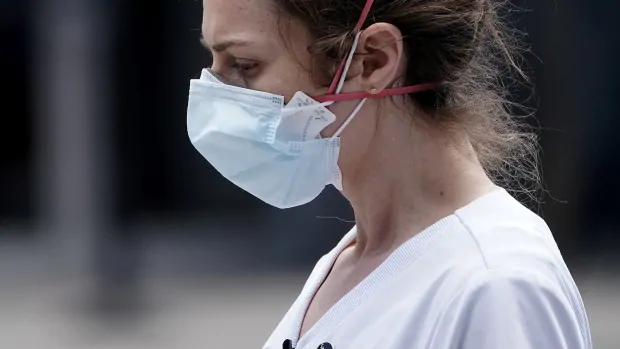As COVID-19 continues its deadly spread across the country, health-care workers on the front lines of the pandemic are having to adapt their behaviour in a variety of ways, both in hospital and at home.
This is an excerpt from Second Opinion, a weekly roundup of eclectic and under-the-radar health and medical science news emailed to subscribers every Saturday morning. If you haven’t subscribed yet, you can do that by clicking here.
As COVID-19 continues its deadly spread across the country, health-care workers on the front lines of the pandemic are having to adapt their behaviour in a variety of ways, both in hospital and at home.
The highly contagious virus that surrounds them on a daily basis informs nearly every decision and every action. The overriding goal is to help patients who are suffering, while also protecting themselves and others, including their loved ones, from catching COVID-19.
Whether it’s how they interact with critically ill patients, including how often; how they eat their meals while on duty; and what they do before they even walk in the door at home after a shift — nearly every routine has changed.
At the system level, Canada is adapting to the crisis by expanding hospital capacity, training staff for new roles and inviting retired health-care workers to return to duty.
Down at individual level, Patty Tamlin of Stouffville, Ont., knows what’s at stake. She works as an intensive care nurse in the Scarborough Health Network’s Birchmount site in Toronto’s east end. Tamlin, 59, was infected with SARS on the job in 2003.

She won’t shy away from caring for patients so long as she’s adequately protected with the proper gear, she said.
The supply of personal protective equipment (PPE) has been a persistent concern of hers as the outbreak continues.
She’s not only concerned about her own safety, but that of her husband, who is recovering from cancer.
“For me, with having somebody who’s immunocompromised at home from chemotherapy, I’m obsessive,” Tamlin said of the precautions she takes to avoid infection.
Tamlin’s not alone in constantly taking extra care. Hospital workers are meticulous about physical distancing at work, including at lunch.
Everyone working in the hospital wears surgical masks. They’re given two per day. At lunch, staff remove their mask to eat, either in the regular staff room, in a conference room or in the lobby to keep away from each other.
“I missed my dinner break [Wednesday] and that will happen more,” Tamlin said. “I am more dehydrated, as I can’t step away to get a drink of water as easily.”
Tamlin said everyone tries to stay cheerful and support each other.
When she arrives home after a shift, she leaves her shoes outside, takes off her clothes immediately once inside to put them directly in the wash, and then hits the shower.
“I wash my hair, everything. I even wash my hair tie, even though … my head is covered all day.”
A nurse’s armour
Tamlin said a big concern is what could happen if a surge in cases on the scale of what happened in Italy or New York City were to occur in Toronto and the supply of N95 masks to treat the sickest patients needed to be rationed.
“A cop has a vest and a gun,” Tamlin said. “I should have a gown and a mask if I’m going to provide care.”

When critically ill patients are in distress, they may need to be intubated by having a tube inserted through the mouth and into the airway. During intubation, virus-laden droplets that are smaller than what we expel in a regular cough spread everywhere.
That’s why health-care workers need to wear N95 masks, face shields and gowns that liquid can’t penetrate, as well as plastic aprons on top of their gowns and other PPE. If the supply of aprons were to run out briefly, as it did in one New York City hospital, Tamlin plans to resort to using garbage bags.
Care teams shrink
Before the pandemic, a team of several doctors, nurses and respiratory therapists would rush into the room if a patient needed to be resuscitated. That was before masks, face shields, gowns, gloves and other gear needed to be preserved.
“Let’s just have the two of us in there,” Tamlin said of how critical care teams work now.
The PPE needs to be put on and carefully removed between patients, along with handwashing and absolutely no touching one’s face. Even a momentary lapse risks exposing a health-care worker to the virus.
Normally, Tamlin would go into a patient’s room whenever called. Now, she tells patients that’s no longer possible.
Instead, she plans to accomplish several tasks in a single visit, such as providing medication, getting blood work, and repositioning a patient in their bed. Tamlin said staff are also trying to use long extension tubes to roll IV pumps out of the room as well, so someone doesn’t need to go in to make adjustments.

When Tamlin looks at hard-hit New York, she admires how front-line workers from elsewhere in the U.S. are leaving their homes and families to help out.
“What I see is our future — our relatively immediate future,” said said, both in Ontario and elsewhere in Canada.
On Thursday, health officials in Ontario announced the death of a hospital worker, a grim first for the province.
The sheer number of people infected worldwide in the pandemic is a major difference from SARS, Tamlin said. SARS resulted in more than 8,000 cases in 2003, according to the World Health Organization. There are already more than 1.3 million COVID-19 cases globally.
‘Tension in your body’
Like Tamlin, Dr. Bruce Lampard, an emergency room physician with Toronto’s University Health Network, is constantly taking precautions to guard against the virus. He said he now washes his hands “hundreds of times a day” and wipes down everything, including his glasses and cellphone, which he keeps covered in a small plastic bag.
He worked in an Ebola treatment centre in Sierra Leone in November 2014 with Doctors Without Borders, and now sits on the group’s international board of directors.
“Going to that project in Sierra Leone, there was just that feeling of a little bit of tension in your body and doing your best to try and use it to keep yourself sharp,” he said. “I feel the same thing now.”
Lampard suspects much of the tension he feels comes from the many unknowns of the pandemic. He said lingering questions about the extent people pass on COVID-19 to others before showing symptoms — or in cases where they seemingly have no symptoms at all — provoke some anxiety.
Still, he keeps a positive outlook and sleeps soundly, confident in his training, he said.
In harm’s way
Dr. Sandy Buchman, president of the Canadian Medical Association, said he’s hearing from physicians across the country about how the uncertainty surrounding supplies of PPE adds to the stress and anxiety they’re feeling.
Buchman said he hasn’t heard of shortages yet, but he wants to see more equipment and information about supply levels so health workers can prepare.
“Ethically,” he said, “there’s a reciprocity on the government’s end, on society’s end, to provide that personal protective equipment to those health-care workers on the front line to protect them when they put themselves in harm’s way.”
WATCH | What you need to know about wearing a mask during the COVID-19 pandemic:
‘The point of the mask,’ says Christopher Labos, ‘is to protect others from you,’ especially if you are an asymptomatic carrier of the virus. 2:58
As a side gig, Tamlin also usually serves as a host at a community radio station. She recently recorded a public service announcement.
The message?
“Stay the heck at home … so that I don’t have to look after as many people.”
To read the entire Second Opinion newsletter every Saturday morning, subscribe.











